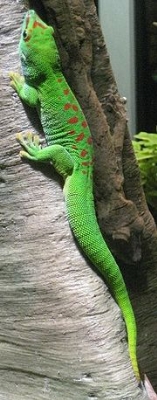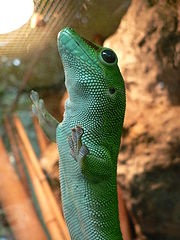
Madagascar giant day gecko
Encyclopedia
Phelsuma madagascariensis grandis Gray
, 1870, is a diurnal
arboreal subspecies
of the day geckos (Phelsuma
spp.). These geckos are part of the Phelsuma group, which consists of 70 species and subspecies. One common name is Madagascar giant day gecko
, being large and is found in areas of tropical and subtropical forest in northern Madagascar
. As with other geckos of the species Phelsuma madagascariensis
, P. m. grandis feeds on various invertebrates and very small vertebrates and nectars.
, 1870 has the synonyms Phelsuma madagascariensis venusta Mertens
, 1964 and Phelsuma madagascariensis notissima Mertens
, 1970 (fide Meier, 1982). The common name, appended to the current accepted name, has been given as Madagascar giant day gecko or variants such as Giant Day Gecko.
 These animals should be housed in pairs or singles and need a large, well planted terrarium. When housed alone they should have at least a 10 gallon terrarium. When housed in pairs they should have at least a 29 gallon terrarium. These geckos need many limbs to crawl and bask on. They prefer horizontal and diagonal ones. Giant day geckos need UVB and UVA. UVB 5.0 is the level they need. They need UVB because it helps them absorb calcium. The temperature should be between 25 and 28°C, never falling below 17°C, and never exceeding 36°C. The humidity should be maintained between 65 and 75%. These geckos desiccate easily and quickly, so falling below this range can be dangerous. Keeping the geckos at humidity above this range can be done, but levels which are too high can introduce dangerous bacteria quickly. In captivity, these animals can be fed with crickets, wax moths, wax worms, pinky mice, fruit flies, mealworms and houseflies dusted with calcium supplement.
These animals should be housed in pairs or singles and need a large, well planted terrarium. When housed alone they should have at least a 10 gallon terrarium. When housed in pairs they should have at least a 29 gallon terrarium. These geckos need many limbs to crawl and bask on. They prefer horizontal and diagonal ones. Giant day geckos need UVB and UVA. UVB 5.0 is the level they need. They need UVB because it helps them absorb calcium. The temperature should be between 25 and 28°C, never falling below 17°C, and never exceeding 36°C. The humidity should be maintained between 65 and 75%. These geckos desiccate easily and quickly, so falling below this range can be dangerous. Keeping the geckos at humidity above this range can be done, but levels which are too high can introduce dangerous bacteria quickly. In captivity, these animals can be fed with crickets, wax moths, wax worms, pinky mice, fruit flies, mealworms and houseflies dusted with calcium supplement.
John Edward Gray
John Edward Gray, FRS was a British zoologist. He was the elder brother of George Robert Gray and son of the pharmacologist and botanist Samuel Frederick Gray ....
, 1870, is a diurnal
Diurnal animal
Diurnality is a plant or animal behavior characterized by activity during the day and sleeping at night.-In animals:Animals that are not diurnal might be nocturnal or crepuscular . Many animal species are diurnal, including many mammals, insects, reptiles and birds...
arboreal subspecies
Subspecies
Subspecies in biological classification, is either a taxonomic rank subordinate to species, ora taxonomic unit in that rank . A subspecies cannot be recognized in isolation: a species will either be recognized as having no subspecies at all or two or more, never just one...
of the day geckos (Phelsuma
Phelsuma
The genus Phelsuma consists of several lizards in the gecko family, commonly referred to as Day Geckos.-Description:In contrast to most other gecko species, day geckos are active mainly during the day. Other diurnal geckos are members of the genus Lygodactylus and the genus Gonatodes...
spp.). These geckos are part of the Phelsuma group, which consists of 70 species and subspecies. One common name is Madagascar giant day gecko
Madagascar giant day gecko
Phelsuma madagascariensis grandis Gray, 1870, is a diurnal arboreal subspecies of the day geckos . These geckos are part of the Phelsuma group, which consists of 70 species and subspecies. One common name is Madagascar giant day gecko, being large and is found in areas of tropical and subtropical...
, being large and is found in areas of tropical and subtropical forest in northern Madagascar
Madagascar
The Republic of Madagascar is an island country located in the Indian Ocean off the southeastern coast of Africa...
. As with other geckos of the species Phelsuma madagascariensis
Phelsuma madagascariensis
Phelsuma madagascariensis is a species of day gecko that lives in Madagascar. It is among the most widespread day geckos and is found in a wide range of habitats. With a length of up to , it is also the largest day gecko in Madagascar...
, P. m. grandis feeds on various invertebrates and very small vertebrates and nectars.
Description
This lizard reaches a total length of 30 centimetres (11.8 in). The body colour is bright green or, rarely, bluish green. A red stripe extends from the nostril to the eye. On the back there are red coloured dots or bars. These red markings are quite variable, and in some cases, completely absent, though the line extending from the nostril to the eye is always present. Some specimens may have small blue spots. Adult specimens may have large sacs on their necks. These are stored calcium sacks. Young individuals of the species often exhibit much more red than their parents, but as time passes, many of the markings fade, to leave those that will remain until the gecko dies. The underside of these animals is a creamy white ranging to an eggy yellow. A stressed animal is more likely to have darker colouration, making it appear as though there are orange parts to the red colouration, and the green appears far darker.Distribution
This species is widely distributed in northern and northwest Madagascar. It can also be found on some of the off shore islets. There are a few recorded populations of this species also in Florida, and Hawaii, introduced by accident, which seem to like the hot, tropical climate in these locations. It can also be found in Mauritius, mainly in Floreal and in the upper Plain Whilems, but it is thought that it was introduced there too.Habitat
Phelsuma grandis is often found on different trees where it can be seen basking. They also inhabit human dwellings due to the number of appropriate basking spots, and the level of insect activity which these dwellings attract. The climate is rather dry, though heavy rainfalls are quite common. This means that there is a constant level of high humidity throughout the year. When in captivity phelsuma grandis enjoy bamboo. Most live on the eastern coast of madagascar.Diet
These day geckos feed on various insects and other invertebrates, and occasionally have been recorded consuming small vertebrates. They also like to lick soft, sweet fruit, pollen and nectar. Geckos in the wild and in captivity have been observed consuming their own young.Behaviour
Like most Phelsuma species, the males can be quite quarrelsome and territorial and will not accept other males in their neighborhood. They only allow females to enter their territory. In captivity, where the females cannot escape, the males can also sometimes seriously wound a female. In this case the male and female must be separated. Breeding behavior includes, the shaking of the tail or body, vocalizing, and if the female does not accept the male she may turn a darker green. The day geckos may move slowly, but when they are startled they can move very fast. They are known for being very good at escaping their enclosures. Giant day geckos have no eyelids. To keep their eyes clean, they often lick them.Common Diseases and Disorders
Every once in a while giant day geckos will have a bad shed. The gecko has skin that does not come off the body. This is common and if the skin doesn’t come off after 24 hours, just mist your day gecko. Many day geckos have problems shedding the skin of their feet. This is of great importance to the day gecko considering they are arboreal. Another large problem with giant day geckos is metabolic bone disease. This happens when your day gecko doesn’t get enough calcium. This can be prevented by making sure your giant day gecko gets plenty of calcium supplements.Reproduction
The breeding season is between November and the first weeks of May. During this period, the females lay up to 6 pairs of eggs. At a temperature of 28°C, the young will hatch after approximately 60–65 days. The juveniles measure 70 mm and reach sexual maturity after one year. When the babies are about two years old they will leave their mother and find a mate or a new home.Nomenclature
The subspecies Phelsuma madagascariensis grandis GrayJohn Edward Gray
John Edward Gray, FRS was a British zoologist. He was the elder brother of George Robert Gray and son of the pharmacologist and botanist Samuel Frederick Gray ....
, 1870 has the synonyms Phelsuma madagascariensis venusta Mertens
Robert Mertens
Robert Mertens was a German herpetologist. The Robert Mertens' day gecko is a species named after him, and he also postulated Mertensian mimicry....
, 1964 and Phelsuma madagascariensis notissima Mertens
Robert Mertens
Robert Mertens was a German herpetologist. The Robert Mertens' day gecko is a species named after him, and he also postulated Mertensian mimicry....
, 1970 (fide Meier, 1982). The common name, appended to the current accepted name, has been given as Madagascar giant day gecko or variants such as Giant Day Gecko.
Care and maintenance in captivity


